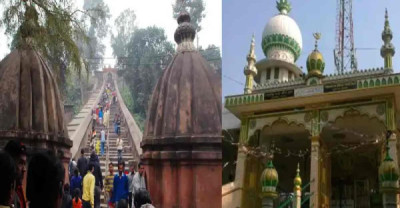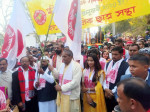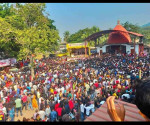History & Traditions
The highlight of the celebration is the “Samanwaya Shobhayatra” (Coordination Procession), where people from different religions — Hindus, Muslims, and Buddhists — come together, reflecting Hajo’s enduring legacy of unity. Leaders and priests from the Hayagriva Madhava Temple and the Powa Mecca Dargah walk side by side, offering a profound message of coexistence.
Initiated in 1992 by the All Assam Students’ Union (AASU), the Manikut Festival has evolved into a grand cultural event featuring celebrities, artistes, and social leaders. It continues to remind everyone that the spirit of Assam lies in its diversity, tolerance, and shared heritage.
Quick Info Table on Manikut Utsav Hajo
| Feature | Details |
|---|---|
| Festival Name | Manikut Utsav |
| Location | Hajo, Kamrup District, Assam |
| Organized By | All Assam Students’ Union (AASU) and local communities |
| First Held | 1992 |
| Celebration Date | First day of Assamese month of Magh (mid-January) |
| Major Attraction | Samanwaya Shobhayatra (Coordination Procession) |
| Cultural Significance | Promotes unity, peace, and communal harmony |
| Key Religious Sites | Hayagriva Madhava Temple, Powa Mecca Dargah |
| Type of Festival | Cultural, Religious, and Social Unity Event |
| Nearest City | Guwahati (Approx. 30 km) |
FAQs with Short Answers
-
Q: What is Manikut Utsav?A: It’s an annual festival in Hajo celebrating communal harmony and peace among all religions.
-
Q: Where is Manikut Utsav held?A: The festival is held in Hajo, a historic town in Assam known for its religious diversity.
-
Q: When does Manikut Utsav take place?A: It’s celebrated on the first day of the Assamese month of Magh, around mid-January.
-
Q: What is the main event of the festival?A: The Samanwaya Shobhayatra, a coordination procession promoting unity and peace.
-
Q: Who started Manikut Utsav?A: It was initiated in 1992 by the All Assam Students’ Union (AASU).
-
Q: What is the message behind the festival?A: It promotes the values of harmony, brotherhood, and coexistence among different faiths.
-
Q: Which religious leaders participate in the procession?A: Priests from Hayagriva Madhava Temple and the Khadim of Powa Mecca Dargah participate together.
-
Q: What makes Hajo special during this festival?A: Hajo becomes a living example of India’s unity in diversity during the celebration.
-
Q: Are tourists allowed to attend Manikut Utsav?A: Yes, tourists are warmly welcomed to witness and join the festivities.
-
Q: What is the significance of Samanwaya Shobhayatra?A: It symbolizes coordination and mutual respect among communities.
-
Q: Which organizations support the festival?A: The All Assam Students’ Union and local cultural bodies.
-
Q: Does the festival include cultural programs?A: Yes, it features performances, songs, and events promoting social harmony.
-
Q: What are the main attractions in Hajo?A: The Hayagriva Madhava Temple, Powa Mecca Dargah, and Kedar Temple.
-
Q: How does Manikut Utsav inspire the youth?A: It encourages young people to embrace unity and respect all religions.
-
Q: What does Manikut mean?A: “Manikut” signifies the sacred space or altar, symbolizing purity and devotion.





